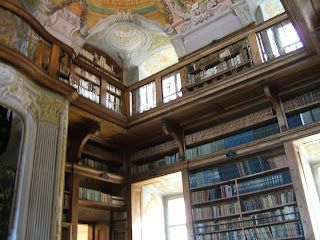Melk Abbey is a Benedictine abbey in Austria. It was founded in 1089 but the buildings you see below were built in the early 18th century. The abbey stands on a hill above the town of Melk and near to the Danube. It is a UNESCO World Heritage site.
As you can see from the photographs a lot of money has been spent on internal and external ornamentation. I suppose that some would justify the expenditure by saying it was done for the greater glory of God. I find it offensive and would have preferred to have seen the money spent on building an orphanage or a hospital for the poor.
The problem is that many of the world great buildings are the product of exploitation of one class by another. In England, exploitation based on military power produced castles, exploitation based on political power produced the Corn Laws and the great country houses. Exploitation based on superstition produced magnificent cathedrals and churches. In Europe it produced Melk and Maulbronn.
 |
| The abbey library |
 |
| There is a wedding in progress. If you look closely you can see the bride and groom |
 |
| Re-usable coffin |
The monastery at Maulbronn [near Baden-Württemberg, Germany] was founded by the Cistercians in 1147. UNESCO describes the monastery as 'the most complete and best-preserved medieval monastery complex north of the Alps".
The Cistercians are an offshoot of the Benedictine order. The order emphasises frugality and hard work, and scorns waste and ostentation. The Benedictines are supposed to do the same, but apparently not enough for the Cistercians.
The Catholic monastery had lots of problems with Protestants during the Reformation and it changed hands several times. Finally, the monastery was secularised in 1807. Parts of the monastery are still used for religious purposes, but the site is open to visitors. There is a charge to enter the church but none to enter the monastery grounds
Melk is very ornate. Maulbronn is not. The church is very spartan. There is non of the Baroque work found at Melk. The Cistercians believed in hard work [to work is to pray] and no money was wasted on ostentation.







No comments:
Post a Comment